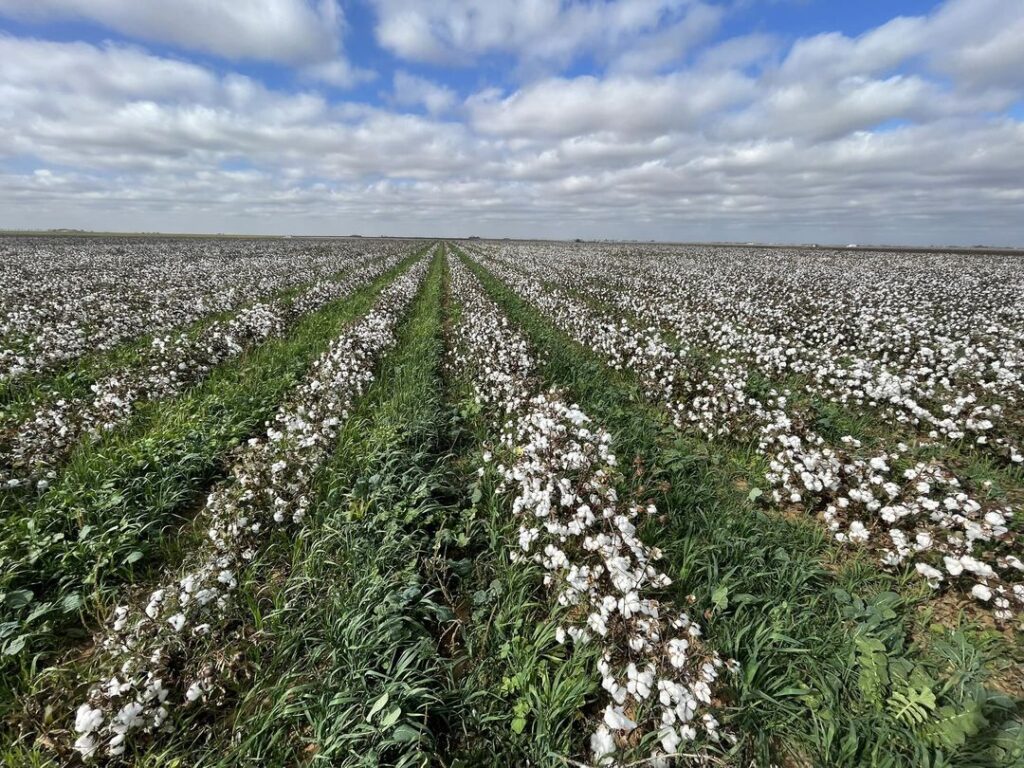You’ve got to have a “Why”
 Jeremy Brown farms in the southern panhandle of Texas. His main crop is cotton, but he also raises a little wheat, rye, and grain sorghum. 70% of his acres are certified organic and the rest soon will be.
Jeremy Brown farms in the southern panhandle of Texas. His main crop is cotton, but he also raises a little wheat, rye, and grain sorghum. 70% of his acres are certified organic and the rest soon will be.
“You know, when you look at the six soil health principles, we’re really trying to implement those as much as possible. Of course, mostly being an organic farm, we are doing some disturbance, but we try to mitigate that with the use of our multi-species cover crops. We try to disturb only during the growing season. And if we’re not growing a cash crop, we try to leave the ground as undisturbed as possible using the cover crops.”
Jeremy is farming in an arid environment with 12-14 inches of rainfall and drought years often mean that he won’t have a crop at all. While limited irrigation capacity on about a third of the acres helps, the water pumping capacity is limited, and it isn’t enough to support a crop on its own if it doesn’t rain.
How he got started
Jeremy’s journey in regenerative agriculture started in 2013 by reading the parable of the sower in the Bible. As he was reading through the passage, he stopped when it talked about the seed landing in the “good soil” and he asked himself, “What is good soil?” That question led him to start looking for better ways to farm and he began to research regenerative farm practices.
In Jeremy’s part of Texas, it is fairly common to plant wheat for a cover crop. But Jeremy wanted to go a step further, so in the fall of 2013 he planted a mix of rye and hairy vetch from Green Cover as an experiment. Jeremy recalls, “I really liked the results I saw, and I began to take a deeper dive into learning about regenerative agriculture practices. I reached out to Green Cover to learn more about different cover crops and how to implement them in my operation and over the next 10 years, I have tried many different ideas. Many failed, but a few ended up being very successful practices for me.”
Cotton and Cover Crops
Today, Jeremy plants his cotton on 80 inch row spacings. While this cuts the production acres in half compared to conventional cotton production, it allows each plant more water to use and gives the cotton plants more growing space. The plants respond by branching out more and putting on an increased number of fruiting positions. This enables the wide row cotton to be more efficient with moisture and fertility while limiting the potential yield drags that come with reduced per acre plant populations.
 A major benefit of the wide rows is that it allows Jeremy to inter-seed his cover crops into the cotton in September, instead of waiting till after harvest finishes in December. Jeremy explains, “In our part of Texas, September is historically the 4th wettest month of the year, giving my inter-seeded covers a good opportunity to get established. The extra three months of growing season my covers get in the fall means they are farther ahead come spring time. In order to conserve spring moisture, I am ready to terminate the covers earlier in the spring if needed.”
A major benefit of the wide rows is that it allows Jeremy to inter-seed his cover crops into the cotton in September, instead of waiting till after harvest finishes in December. Jeremy explains, “In our part of Texas, September is historically the 4th wettest month of the year, giving my inter-seeded covers a good opportunity to get established. The extra three months of growing season my covers get in the fall means they are farther ahead come spring time. In order to conserve spring moisture, I am ready to terminate the covers earlier in the spring if needed.”
Economic Impact
Over the years one of the most important realizations for Jeremy was to stop trying to out perform his dry environment. Rather than focusing on producing the maximum amount of cotton per acre, he now focuses on producing the most profitable cotton per acre. He achieves this by limiting his inputs and only spending money on things that will bring him a good return. “We cut all these inputs like synthetic fertilizers, chemicals, and I don’t even do composting, and instead we just focus on the soil health principles.” The economics of Jeremy’s farm have improved thanks to his regenerative and organic practices. By combining the higher market premiums for organic cotton with his low input approach to farming, Jeremy has improved his bottom line. He has also greatly limited his downside risk when droughts come, since he doesn’t have as much money invested in each crop.
Advice for Others
10 years into his regenerative journey Jeremy still believes he has a long way to go. Jeremy encourages people to start small and try a few new ideas on a limited number of acres. He encourages others to get connected to a network of regenerative farmers for support and learning. Most importantly Jeremy thinks you need to have the proper motivation since this will drive you and keep you going when things don’t go well. “I think you have to have a why and for me my why is my faith. I’m a steward of God’s land. This is not mine. This is His, He created this to function and He declared it to be good. My job is to figure out a way to get back to the way He designed it.” One day I will be gone, and unless Christ returns before that, this land will still be here and I will leave it better than how I found it”
Dive into over 90 pages packed with scientific articles and fascinating stories from soil health experts, researchers, farmers, innovators, and more! All as our complimentary gift to you, a fellow soil health enthusiast!
Read the Whole Guide
This article first appeared in the 10th Edition of Green Cover's Soil Health Resource Guide.
 Jeremy Brown farms in the southern panhandle of Texas. His main crop is cotton, but he also raises a little wheat, rye, and grain sorghum. 70% of his acres are certified organic and the rest soon will be.
Jeremy Brown farms in the southern panhandle of Texas. His main crop is cotton, but he also raises a little wheat, rye, and grain sorghum. 70% of his acres are certified organic and the rest soon will be.  A major benefit of the wide rows is that it allows Jeremy to inter-seed his cover crops into the cotton in September, instead of waiting till after harvest finishes in December. Jeremy explains,
A major benefit of the wide rows is that it allows Jeremy to inter-seed his cover crops into the cotton in September, instead of waiting till after harvest finishes in December. Jeremy explains, 